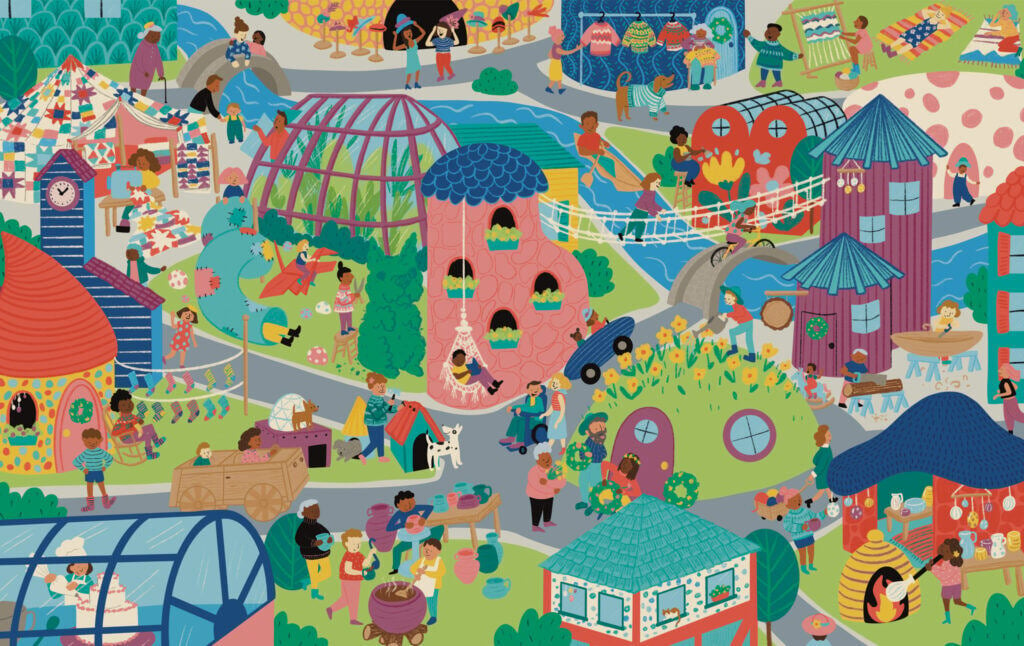
Dispatches From The Good Future
Where will humanity be a few decades from now? Our correspondent from the future files a report.
Dateline: 2056 A.D.—Humanity has made it to The Good Future. There were a lot of bad futures we could have ended up in, but somehow we managed to avoid them. Yay humanity! Maybe we’re not so incorrigible, malicious, and stupid after all. Maybe there’s hope for us! Current Affairs has obtained some exclusive images and testimonies from our wondrous tomorrow on what we shall accomplish together in this new world.
How We Rewilded the Suburbs

We were destroying an awful lot of the natural world, and realized it needed to stop. Wild animals were given almost no consideration when new developments were designed, and as a result they were struggling to survive. The birds weren’t singing in the spring anymore. Nearly all the butterflies were dead. Well, we finally decided that animals are important. We took some of our more useless and depressing suburbs and turned them over to nature, which made something much better out of them. We filled our cities with wild animals, too, which made for a most interesting experience.
How We Met The Aliens

A lot of people were afraid to contact aliens. “What if they’re like us, and colonize and destroy everyone weaker than them?” Fortunately, the aliens turned out to be socialists, and we all get along well together now, despite some amusing cultural misunderstandings here and there.
How We Demolished The Walls

Borders were a nuisance and an injustice. For some reason, even though militarized borders hadn’t existed for most of human history, we’d become used to them and stopped thinking of them as an absurd restriction on freedom. Well, we finally woke up and saw how silly it was to draw lines on the Earth and put up walls to stop people crossing them. Borders were abolished and we all smashed the walls together.
How We Kept Ourselves From Boiling

We finally realized we ought to do something about climate change, and just in the nick of time. “Hey,” humanity said to itself, “why do we constantly talk about the need to switch to green energy but we never seem to actually do it?” Everyone agreed this was a very good point. So we shot Joe Manchin into space and passed a comprehensive Green New Deal that set us on the path to eliminating our carbon emissions. Solar panels were erected over every parking lot, which turned out to not only provide a lot of power but made your (electric) car much more pleasant to get into on a sticky summer day. Vast wind farms crisscrossed the nation, and we researched remarkable new storage technologies to make sure we always had energy on hand. (We still haven’t got fusion, alas.) The nations of the world finally got off their asses and realized it made no sense to compete instead of collaborate on stopping problems that threatened us all.
How We Redesigned The Buildings

Buildings had become boring and everyone knew it. A skyscraper in Dubai looked like a skyscraper in London, and there was almost no point going anywhere anymore, because every place was beginning to look identical and deathly dull. So a movement developed for eclecticism in architecture, emphasizing the importance of local variation and experimentation. Minimalism died a quick death. Soon people were coming up with all kinds of buildings that looked like nothing we had ever seen before. The built environment came alive again! Wherever you looked, there was something remarkable to behold.
How We Made Ourselves More Free

We realized something in the 2030s: it’s fun to wear costumes. But there was a stifling social convention that said you could only dress boldly on Halloween and Mardi Gras. This, it was eventually recognized, was silly and arbitrary. So a new custom developed: wear whatever the hell you like, whenever you like, and you won’t be judged. If you want to walk down the street dressed as a giant insect, or a daffodil, it is your God-given right to do so, and nobody’s going to look at you askance or ask you suspicious questions in a job interview. It turned out that once all social judgment had been removed from dress styles, people’s true selves came out, and those selves were wild. But this, too, made the world more interesting to walk around and look at.
How We Built Playground Towns

Playgrounds are great. Everyone knows this. But many playgrounds are small and pitiful. “Wouldn’t it be better?” humanity asked itself one day, “if there were playgrounds the size of entire towns?” And because everyone agreed instantly that this would indeed be much better, the Playground Towns were commissioned and built. They were something like theme parks, but free to the public and filled with endless nooks and crannies to get lost in. (Yes, finding children in the playground town was a nightmarish inconvenience for parents, but it’s the way the children wanted it.) Everyone got to build the playground towns together, meaning that if you wanted to built a giant sculpture of a tuba with a slide down into the middle, the government would provide you with supplies and help you recruit volunteer builders. Everyone agreed that the only thing more fun than building the playground towns was playing in them afterwards.
How We Gave Everyone What They Needed

Free college, free healthcare, free housing: we made sure that all of people’s basic needs were covered. It turned out not to be terribly difficult. The hard part was getting people to start caring about strangers more, not finding the resources to care for those strangers.
Text by Nathan J. Robinson, illustrations by Ellen Burch. For more detail on what the Good Future is like, read the free utopian socialist novel “My Affairs: A Memoir of the Magazine Industry (2016-2076)“




